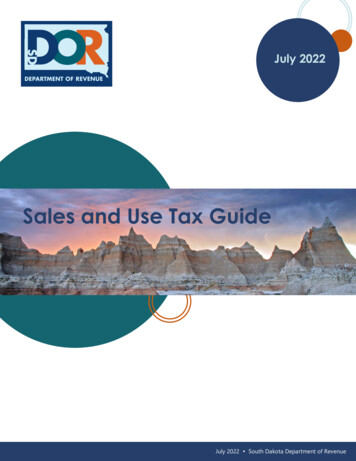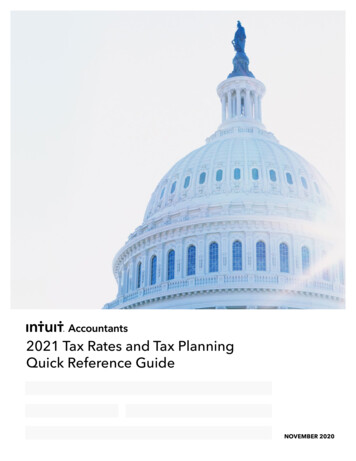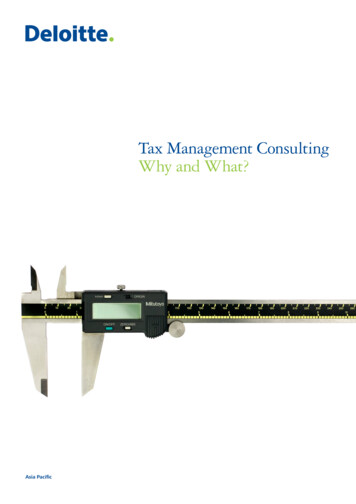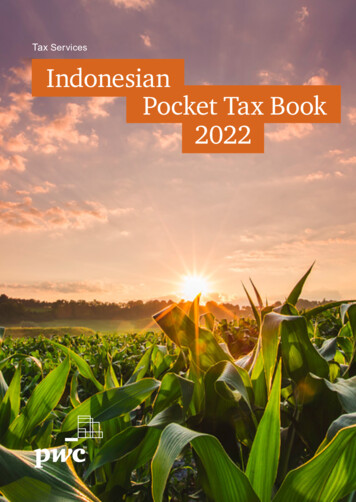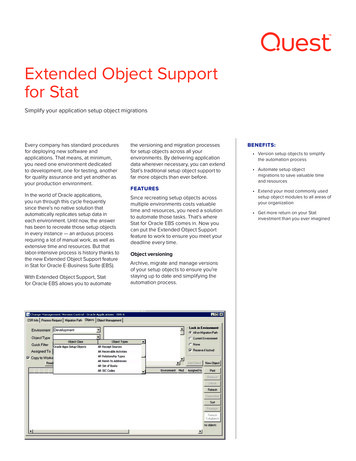
Transcription
Florida’s TransportationTax SourcesA Primer2022Office of Work Program and BudgetFlorida Department of Transportation
Florida’s Transportation Tax Sources: A Primer 2022IntroductionThis document discusses taxes and fees in place, primarily at the state level, that fundthe development and maintenance of Florida’s transportation system. Readers shouldbe aware of the possibility of changes to taxes and fees subsequent to the publication ofthe document.Please direct questions and suggestions concerning this document to:Dan CashinFinance, Program and Resource Allocation ManagerOffice of Work Program and BudgetFlorida Department of Transportation605 Suwannee Street, Mail Station 21Tallahassee, FL 32399-0450(850) 414-4428Daniel.Cashin@dot.state.fl.usPage 1
Florida’s Transportation Tax Sources: A Primer 2022Transportation FundingChapter 334, Florida Statutes (F.S.), authorizes the Florida Department ofTransportation (FDOT) to assume the responsibility for coordinating the planning of asafe, viable, and balanced state transportation system serving all regions of the state,and to assure the compatibility of all components, including multimodal facilities.In carrying out its duties, FDOT adopts a 5-year work program which is a list oftransportation projects planned for each fiscal year. State taxes and fees, along withfederal aid, make up the primary funding sources for the work program. Other fundingsources include tolls collected in certain facilities, proceeds from bond issuances, andlocal taxes and fees.State Taxes and FeesSection 206.46, F.S., authorizes the creation of the State Transportation Trust Fund(STTF), which is used by FDOT to account for the administration of the maintenanceand development of the state highway system and other transportation related projects.STTF’s primary revenue sources from state taxes and fees include fuel taxes and motorvehicle license related fees.Source: Transportation Revenue Estimating Conference (August 2021), Documentary Stamp TaxRevenue Estimating Conference (August 2021).Page 2
Florida’s Transportation Tax Sources: A Primer 2022Fuel TaxesMotor fuel and diesel fuel are subject to state taxation pursuant to ch. 206, and s.212.0501, F.S. State taxes include Highway Fuel Sales Tax (indexed annually by theConsumer Price Index), Off-Highway Fuel Sales Tax, State Comprehensive EnhancedTransportation System Tax (indexed annually by the Consumer Price Index),Constitutional Fuel Tax, County Fuel Tax, Municipal Fuel Tax, and Aviation Fuel Tax.Federal and local option taxes are also levied on motor fuel and diesel fuel. Refer toAppendix 2 for current fuel tax rates and uses.The collection of state fuel taxes is administered by the Florida Department of Revenue.While most revenue from the Fuel Sales Tax is distributed to the STTF, set-asides areincluded for the Marine Resources Conservation Trust Fund, Fish and WildlifeConservation Commission, and the Agriculture Emergency Eradication Trust Fund.Highway Fuel Sales TaxTax TypeState Fuel , 212.0501,206.9955(2)(e),F.S.2022 Rate15.0 cents pergallonUseAt least 15% ofcertain staterevenues depositedinto the STTF mustbe dedicated forpublictransportation.Remainder for anylegitimate statetransportationpurpose.Highway fuel taxes constitute the oldest continuous source of dedicated transportationrevenues in the state. Initially levied in 1921 at the rate of 1 /gallon, the taxexperienced periodic increases until 1971, when the rate was set at 8 /gallon. This rateremained constant until 1983, with the proceeds being shared equally between FDOTand local governments. Beginning in 1972, counties were permitted to tack on thestate's levy by imposing additional taxes of their own on highway fuels and receiving theassociated proceeds.In April 1983, the state's fuel taxes were substantially restructured. FDOT’s share of theexisting excise tax was repealed so the remainder became the local government sharewhich continues to be distributed to counties (3 /gallon) and municipalities (1 /gallon).In place of the repealed FDOT share of the excise tax, a sales tax was applied to thesales of all motor (gasoline) and diesel fuels, with the proceeds earmarked to FDOT.Page 3
Florida’s Transportation Tax Sources: A Primer 2022Initially, the fuel sales tax was applied at the state's general sales tax rate of 5%;however, the way in which this tax was applied to fuel sales differs considerably fromthe method used for all other eligible sales. Whereas a sales tax is typically applied tothe total amount of a purchase during a retail transaction, the fuel tax was appliedagainst a legislated retail price per gallon at the point of wholesale distribution.In effect, the sales tax was administered for collection and perceived by the public as acontinuation of the previous excise tax, although the rate per gallon was higher. Thelegislated average price of all motor and special fuels was initially set at 1.148/gallon.At a 5% tax rate, this resulted in a tax of 5.7 /gallon. Between July 1, 1985 and July 1,1990, this legislated price was adjusted in proportion to annual changes in the gasolinecomponent of the Consumer Price Index (CPI). Except for one statutory provision, theresulting tax per gallon would have varied accordingly. That provision was enacted bythe 1985 Legislature which installed a ‘floor’ beneath the tax, preventing it from beingreduced below its initially calculated level of 5.7 /gallon, regardless of downward gasprice movements. Otherwise, the system operated as an "indexed" fuel tax, withchanges to the national average price of gasoline serving as the index.The 1990 Legislature made several significant changes to the sales tax, effectiveJanuary 1, 1991. First, it raised the rate of the tax from 5% to 6%, regaining parity withthe state's general sales tax rate which had been increased a couple of years earlier.Second, it changed the index to which the legislated price was tied, from the gasolinecomponent of the CPI to the more comprehensive CPI (all items). This was a muchless volatile index, one that normally could be forecasted more accurately, betterreflecting the FDOT's overall costs. Third, though the legislated base price of 1.148was retained, the base period to which future index values were to be compared wasmoved forward from a 12-month period in FY 1983-84 to FY 1988-89. Finally, tax ratechanges became effective each January 1, as opposed to July 1. Consequently, agiven tax rate was made effective during an entire calendar year, instead of a fiscalyear. Additionally, in order to provide for an immediate inflow of incremental revenue,the minimum tax (floor) was adjusted upward from 5.7 /gallon to 6.9 /gallon, effectiveJuly 1, 1990. The new figure reflected the result of applying a 6% rate to the legislatedprice of 1.148. This procedure remained in place through December 1996.Beginning January 1,1997 the method of determining the sales tax was modified. Thelegislated price of 1.148 and the sales tax rate of 6% were no longer ‘direct factors’ inthe calculation. Instead, the ‘floor tax’ of 6.9 /gallon was then indexed to the CPI (allitems), and the base indexing period remained the same 12-month period as in FY1988-89. The terminal supplier collected almost all of the tax.The 2004 Legislature approved a one-time fuel tax holiday of 8 /gallon for the month ofAugust 2004. It also appropriated 58 million from the General Revenue Fund to theSTTF to offset the estimated revenue loss of fuel receipts during FY 2004-05.Page 4
Florida’s Transportation Tax Sources: A Primer 2022Off-Highway Fuel Sales TaxTax TypeNon-Highway FuelTaxReference206.41(1)(g),206.87(1)(e),206.606, 212.0501,206.9955(2)(e),F.S.2022 Rate6% of the retail fuelpriceUseAt least 15% ofcertain staterevenues depositedinto the STTF mustbe dedicated forpublictransportation.Remainder for anylegitimate statetransportationpurpose.As the name indicates, off-highway, or non-highway, fuel (in this case, dieselexclusively) is consumed in various ‘off-the-road’ activities. Intrastate railroads,commercial vessels, and construction equipment account for most of the receiptsgenerated by the tax.Prior to 1983, taxation of such fuel was accomplished under the state's general salestax laws. By definition, fuel excise taxes on diesel fuel applied then, as now, only to fuelconsumed in vehicles subject to registration under the state's motor vehicle licensinglaws; in other words, fuel used on the highways. However, when the Legislatureenacted the sales tax on fuels in 1983, it omitted the restrictive definitions that prevent abroader application of the excise tax. Consequently, this tax applied to fuel formachinery, equipment, and certain vehicles which were not specifically exempt from thetax.Through June 1996, the sales tax applied to a gallon of off-highway fuel equivalent tothe sales tax applied to a gallon of highway fuel. Beginning July 1, 1996, one gallon ofoff-highway fuel is taxed at 6% of the fuel's retail sales price. Fuel used by farmers andcommercial fishermen, once major components, were granted exemptions from the taxin 1988.Page 5
Florida’s Transportation Tax Sources: A Primer 2022State Comprehensive Enhanced Transportation System (SCETS) TaxTax TypeSCETS 9955(2)(d),F.S.2022 Rate8.3 cents per gallonUseNet receipts mustbe spent in thedistrict wheregenerated.The 1990 Legislature levied an additional excise tax on all highway fuels, effectiveJanuary 1, 1991. This tax took the place of a statutory provision which permitted theformation of Metropolitan Transportation Authorities (MTAs) within certain urbanizedcounties. Once formed, these MTAs were to have broad powers, including those ofbeing able to impose additional fuel taxes within their jurisdictions. Mainly because theplans of such authorities and the taxes with which to fund them were subject to approvalby referendum, no urbanized area was able to implement the concept. Therefore, theLegislature repealed the authority to form MTAs and, instead, levied a substitute excisetax which was to be near statewide in scope, and the proceeds of which would bedeposited into the STTF.The tax is unique in several respects. First, its proceeds must be spent in thetransportation district and, to the extent feasible, in the county from which they arecollected. Second, the rate of the tax on gasoline varies by county and was initially setat two-thirds of the total optional fuel tax rate that existed in each county, not to exceed4 /gallon. Finally, the SCETS tax on diesel fuel was imposed at a standard rate of1 /gallon in every county and increased at the rate of one additional cent per galloneach year, until it reached the maximum SCETS tax on gasoline, regardless of theprevailing rate of optional taxes.Like the fuel sales tax, the SCETS tax is indexed to the general rate of inflation (CPI, allitems). In this case, however, the base year for the value of the index is FY 1989-90.Beginning January 1, 1992, and each year thereafter, the SCETS tax rate for bothgasoline and diesel in each county is adjusted proportionately to the change in the CPIduring the previous applicable 12-month period, and, as with the sales tax, the revisedrates apply for the entire calendar year.Page 6
Florida’s Transportation Tax Sources: A Primer 2022Constitutional, County, and Municipal Fuel TaxesConstitutional, County, and Municipal Fuel Taxes originate from the previously imposedexcise tax of 4 /gallon and continue to be distributed to local governments. Two cents,or the Constitutional Fuel Tax, was initially levied under s. 16 of Article IX of the StateConstitution of 1885, as amended. Its formula for distribution to the counties iscontained in s. 9(c)(4) of Article XII of the revised State Constitution of 1968. The firstuse of the proceeds is to meet the debt service requirements, if any, on local bondissues backed by the tax proceeds. The balance, called the 20 percent surplus and the80 percent surplus, is credited to the counties' transportation trust funds. The third centis the County Fuel Tax. It is levied under s. 206.41, F.S., and distributed by the sameformula as the Constitutional Fuel Tax. The fourth cent is termed the Municipal FuelTax and is levied under s. 206.41, F.S. Revenues from this tax are transferred into theRevenue Sharing Trust Fund for Municipalities, combined with other non-transportationrevenues, and distributed in accordance with criteria contained in ch. 218, F.S.Aviation Fuel TaxWhen the state first levied its 1 /gallon excise tax on fuels in 1921, the tax applied to allmotor fuels, including those used in aircraft engines. At that time, aviation was in itsinfancy and accounted for only a minor portion of total fuel consumption. However, by1935, the fuel tax rate had reached 7 /gallon, and aviation activities were increasingsubstantially. To help promote the development of the industry, the Legislatureexempted all aviation fuels from the excise tax.Aircraft fuels remained totally exempt from state taxation until 1963, when theLegislature decided to apply the full sales tax on fuels used in general aviation andintrastate carrier operations and a "prorated" tax on fuels consumed in interstate andforeign commerce.Proration was a system whereby a carrier purchasing fuel in Florida paid only a portionof the total sales tax for which it normally would be liable. The share any carrier (airlinecompany) paid was in direct relation to the proportion that its miles traveled withinFlorida's airspace bore to its total, worldwide fleet mileage. On average, prorationresulted in the state realizing only about 6% of the fuel tax revenues that would havebeen collected from interstate and foreign carriers had they been subject to full taxationon their fuel purchases.In April 1983, the Legislature restructured the state's aviation fuel taxes. First, itpermitted aviation fuels to remain exempt from the state's fuel excise taxes and anyadditional taxes that local governments were authorized to impose. Second, thepractice of prorating the fuel taxes owed by interstate and foreign air carriers wasterminated, and all aviation fuels were subject to the same sales tax that was levied onPage 7
Florida’s Transportation Tax Sources: A Primer 2022highway fuels. Finally, collections of aviation fuel taxes were earmarked for use by theFDOT.Subsequent to the enactment of the new aviation fuel tax, many major airlinecompanies filed a lawsuit challenging the legality of the tax. While the lawsuits were inprogress, the litigants were permitted to place their related tax payments into escrow.Although the state judiciary upheld the constitutionality of the tax, its decisions wereappealed to the U.S. Supreme Court. In the meantime, in order to break the revenuestalemate, the 1985 Legislature modified the aviation fuel tax structure. Instead of thetax being calculated as a percentage of an artificial retail price, it was set at a constant5.7 /gallon and re-established as an excise tax. In addition, the proceeds of the taxwere directed to the state's General Revenue Fund, instead of STTF.Soon after the 1985 Legislature adjourned, the U.S. Supreme Court refused to hear theappeals filed by the domestic airlines. This refusal effectively exhausted the legalrecourse available to these carriers and subjected them to the decision of the Floridacourt. Since then, all have remitted their previously escrowed taxes, with interest, to thestate. Except for the General Revenue service charge, these payments weredistributed to the FDOT. The U.S. Supreme Court did accept jurisdiction in the casesbrought by the foreign airlines, but in June 1986 rejected their appeals. Hence, thesecarriers also became obligated to pay their back-taxes.The 1986 Legislature redirected the proceeds of the aviation fuel tax to the STTF afterdeductions for administrative costs and the General Revenue service charge. The taxremained at 5.7 /gallon purchased in the state, although airlines with Florida-basedemployees became eligible for refunds of fuel taxes paid in an amount equivalent to apercentage of the employees’ in-state wages.In 1990, the Legislature raised the aviation fuel tax rate to 6.9 /gallon. The rate wouldremain until changed by legislative action.In 1996, the Legislature granted an exemption from payment of the aviation fuel tax, inthe form of a refund, to any air carrier offering transcontinental jet service which, afterJanuary 1, 1996, increases its Florida workforce by more than 1000 percent and by 250or more full-time equivalent employee positions. This aviation fuel tax refund wasoriginally intended as a short-term incentive to attract new airline carriers to the state.Following the tragic events of September 11, 2001, the Legislature extended this refundpolicy with no expiration date.In 2016, the Legislature passed legislation that would remove aviation refunds availableto certain airlines and lower the aviation fuel tax rate to 4.27 beginning in FY 2019-20.Page 8
Florida’s Transportation Tax Sources: A Primer 2022Local Fuel TaxesThe population growth experienced during the decades of the sixties and seventies,coupled with high rates of inflation, placed capital demands on local governments whichfar exceeded their existing revenue-raising ability. Initially, much of this demand wasfocused on the need to improve and expand the transportation system for whichcounties and cities were responsible. Hence, in 1972, a precedent was establishedwhen the Legislature authorized counties to tack on a limited impost of their own inaddition to the state's excise tax on highway fuel.Ninth-Cent Fuel TaxOriginally labeled the Ninth-Cent tax when the state's fuel excise taxes totaled 8 cents,this tax was first authorized in 1972 by s. 336.021, F.S. It was renamed the Voted GasTax in 1983 when the state's fuel taxes increased to 9.7 /gallon. The tax is limited to1 /gallon on highway fuels, has no time limit and, until 1992, had to be approved by theelectorate in a countywide referendum. The 1992 Legislature authorized "small"counties (those with a population of 50,000 or less on April 1, 1992) to impose the taxby an extraordinary (majority plus one) vote of their governing bodies. Since areferendum no longer was necessary in every case the tax was, rather inappropriately,re-designated its original name.In 1993, the Legislature removed the referendum requirement entirely so that anycounty, regardless of size, could now impose the tax by extraordinary vote of its Boardof Commissioners. The tax assumed its current name in 1996. The proceeds of the taxmay be shared with cities in whatever proportion agreed upon.Beginning January 1, 1994, the Ninth-Cent tax on diesel fuel was no longer optional.The 1990 Legislature decided to equalize all optional taxes on diesel fuel so thatinterstate truckers, who pay fuel taxes based on miles driven in the state, would besubject to standardized tax rates. Currently, 55 of 67 counties in Florida haveimplemented the Ninth-Cent Fuel Tax.Local Option Fuel Tax (1 to 6 Cents and 1 to 5 Cents)The 1983 Legislature provided local governments with a new source of revenue.Originally called the Local Option Gas Tax and renamed the Local Option Fuel Tax in1996, it is described in s. 336.025, F.S. Initially, it was established as a tax of 1 to 4 on each gallon of highway fuel, which could be levied at the option of a county'sgoverning body for a maximum period of five years, and whose proceeds were requiredto be shared with municipalities. It was to be collected at the wholesale level along withthe fuel excise taxes and the fuel sales tax. While the tax retains some of its originalcharacteristics, it has also undergone significant change since it was first authorized.Page 9
Florida’s Transportation Tax Sources: A Primer 2022The tax was initially imposed during an early special session of the Legislature. Thatsame year, when the Legislature returned for its regular session, it extended themaximum duration of the tax to ten years in order to make it at least minimally suitableas a security against which to issue debt. Then in 1985, counties were authorized toraise the maximum rate of the tax to 6 per gallon and its duration to 30 years. At thesame time, collection of the tax was moved to the retail level in order to positivelyidentify the location and the tax rate at which each gallon of fuel was sold. To make taxadministration more efficient for both the state and the fuel industry, the tax collectionpoint was shifted to the wholesaler (for gasoline and gasohol) and the terminal supplier(for diesel fuel), beginning in July 1996.The 1990 Legislature chose to equalize the Local Option Fuel Tax on diesel fuel.Beginning January 1, 1991, the minimum tax rate on diesel fuel was set at 4 /gallon.Then, on January 1 of each of the following two years, the minimum rate rose by onecent until it reached 6 /gallon on January 1, 1993.At first, proceeds of the tax could only be used for transportation purposes. However, ina major departure from the user-fee concept, the 1992 Legislature authorized any ‘smallcounty’ (with 50,000 or fewer people as of April 1, 1992) to use the proceeds for othercapital infrastructure needs, if the transportation element of its comprehensive plan hadbeen fully satisfied. This exception applies only to the six cents of tax authorized priorto 1993.The most significant change occurred in the 1993 legislative session, when countieswere accorded the option of imposing still another 1 to 5 on each gallon of motor fuel(gasoline and gasohol, but not diesel). With this latest authorization, counties were ableto levy a tax of up to 11 on each gallon of gasoline, while the rate for diesel remainedstandard in every county at 6 per gallon. The first six cents of the tax on motor fuelmay be imposed by a majority vote of the Board of County Commissioners or a countywide referendum initiated by either the county commission or municipalitiesrepresenting more than 50% of the county's population. To impose the remaining fivecents, however, an extraordinary vote of the county commission or a county-widereferendum initiated by the commission is required.The proceeds of the tax must still be shared with municipalities, either in accordancewith a mutually agreed upon distribution scheme (which is subject to periodic review) or,if agreement cannot be reached, by using a backup formula contained in the statute. Alocal government may pledge any of its revenues from the tax to repay state bondsissued on its behalf and, in addition, may use such revenues to match state funds in theratio 50%/50% for projects on the State Highway System, or for other road projectswhich would alleviate congestion on the State Highway System.Page 10
Florida’s Transportation Tax Sources: A Primer 2022Currently, all counties in Florida have implemented the full 6 cents of the 1 to 6 CentsLocal Option Fuel Tax, and 37 counties have implemented some or all of the 1 to 5Cents Local Option Fuel Tax.Federal Fuel TaxesThe first federal gasoline tax in the U.S. was created with the enactment of the RevenueAct of 1932 with a tax of 1 /gallon. Since 1993, the U.S. federal gasoline tax has been18.4 /gallon. The current tax rate for diesel fuel is 24.4 /gallon. At the federal level,the majority of the taxes are collected when product is removed from the bulk storageterminals. The companies pay the tax to the Internal Revenue Service.The revenue from the collected federal fuel taxes are deposited into the FederalHighway Trust Fund, which has several accounts. Generally, the Leaking UndergroundStorage Tank Trust Fund receives 0.1 cent per gallon of the fuel tax, the Mass TransitAccount of the Highway Trust Fund receives 2.86 cents per gallon and the HighwayAccount of the Highway Trust Fund receives the remainder.Fuel taxes are only one of several sources of federal highway user charges that aredeposited into the Federal Highway Trust Fund. Funds are distributed to the statesfrom the Federal Highway Trust Fund through a system of formula grants anddiscretionary allocations by the Federal Highway Administration.Alternative Fuel FeesAlternative fuels are non-conventional fuels such as propane, butane, and otherliquefied petroleum gases (LPG) or compressed natural gases (CNG). Use of suchfuels represents only a very small part of the state's total fuel consumption. Totalstatewide receipts from the fees on alternative fuels historically amounted to less than 1 million annually. Prior to January 2014, owners of vehicles titled in Florida paid theirfuel taxes through the purchase of an annual decal, the price of which varied accordingto the type of vehicle involved and the total amount of state and local diesel fuel taxes ineffect in the county of residence. Out-of-state vehicles incurred their tax at the pump atthe equivalent of the SCETS, Constitutional, County, Municipal, Ninth-cent, and LocalOption taxes on diesel fuel. Collections were distributed to the regular recipients of andin proportion to the taxes upon which the Alternative Fuel Fees were based. In order toencourage the use of alternative fuels, the 2013 Florida Legislature passed legislation toexempt these fuels from taxation beginning January 1, 2014 and ending January 1,2024.Page 11
Florida’s Transportation Tax Sources: A Primer 2022Fuel Use TaxImposed by the Florida Special Fuel and Motor Fuel Use Tax Act of 1981, this tax isdesigned to ensure that heavy vehicles which engage in interstate operations incur taxesbased upon fuel consumed, rather than purchased, in the state. Prior to the law'spassage, operators of such vehicles were able to buy fuel (often at lower prices) in aneighboring state, use the fuel on Florida's roads, and, if the state in which the fuel wasbought had a similar tax, receive a refund for taxes paid but not incurred. Thus, Florida'sroads received uncompensated damage, vehicles consumed untaxed fuel, and the state'sretail fuel outlets, particularly those in the northern tier, were deprived of sales thatotherwise might have occurred.Every state in the nation now imposes such a tax via the International Fuel TaxAgreement. In Florida, it applies, with few exceptions, to each privately-owned vehiclewith at least three axles or a gross weight of more than 26,000 pounds that engages ininterstate operations, whether or not titled in this state. The tax is comprised of an annualdecal fee of 4.00 plus a use tax based upon the number of gallons of fuel consumedmultiplied by the prevailing statewide fuel tax rate. The decal serves as an identifyingdevice to validate that a vehicle is registered to use the state's roads and to ensure receiptof applicable tax returns. If, during a reporting period, a vehicle consumes more fuel thanwas purchased, additional taxes are due. Otherwise, a credit or refund is issued.Distributions of tax receipts are made to the recipients of and in proportion to the taxesthat are used to calculate the total Fuel Use Tax rate.Page 12
Florida’s Transportation Tax Sources: A Primer 2022Motor Vehicle License Related FeesFunding transportation from vehicle-related revenues started very early in Florida'stransportation history. Almost from their inception, motor vehicle license fees weredesignated as a highway user charge levied to partially defray the costs of constructingand maintaining the roads which benefited those who paid the fees. This philosophyremains a part of the current vehicle registration statutes.Recognizing the tremendous burden that a rapidly growing vehicle fleet was placing onthe state's highway system, the Legislature in 1990 included new vehicle fees in themajor transportation funding package enacted that year. Those fees included the initialregistration ("New Wheels on the Road") fee and the motor vehicle title fee.With the exception of the rental car surcharge, the Department of Highway Safety andMotor Vehicles administers the collection of motor vehicle license related fees,governed by chs. 319 and 320, F.S. Fees collected are distributed pursuant to statutoryrequirements to the General Revenue Fund, Highway Safety Operating Trust Fund,STTF, Transportation Disadvantaged Trust Fund, Department of Education Trust Fund,and other funds.Motor Vehicle License FeesAlthough these fees provided the very first funding source for FDOT's activities (1915),their use for transportation was terminated in 1931. Not until 1977, when theLegislature directed that 36.5% of the gross proceeds from the tax be deposited into theSTTF, was the original intent of the fees at least partially reinstated.In 1981, an additional part of the proceeds was earmarked to transportation when theLegislature discontinued using any of the fees as a general fund source, and, instead,dedicated the previous general revenue share to completing the state's InterstateHighway System. That change resulted in a three-way distribution which allocated theconstitutional first proceeds to educational needs, the second proceeds to generaltransportation needs, and the remainder to the Interstate System exclusively.In May 1983, both the fee structure and the system of distribution underwent substantialchange. Annual fees on autos and small trucks were increased modestly depending onweight class, while fees for the three heaviest categories of truck-tractors were raisedmore substantially. The distribution scheme was altered so that the annual Interstateshare of revenues was reduced to a constant 25 million, with the residual (excludingeducation's first proceeds) earmarked to general transportation needs.In 1985, the Legislature decided that a separate state source of Interstate funding wasno longer required, and so it abolished the dedicated fund into which part of the licensePage 13
Florida’s Transportation Tax Sources: A Primer 2022fees had b
Transportation (FDOT) to assume the responsibility for coordinating the planning of a safe, viable, and balanced state transportation system serving all regions of the state, and to assure the compatibility of all components, including multimodal facilities. In carrying out its duties, FDOT adopts a 5-year work program which is a list of




